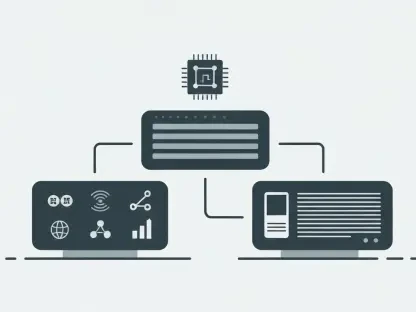As the digital financial landscape evolves, so do the methods employed by fraudsters to exploit vulnerabilities. Account takeover fraud has seen a disturbing rise, posing significant threats to individuals and organizations alike. This escalation has put immense pressure on traditional security systems to adapt swiftly. Open Banking emerges as a formidable solution in this battle against fraudulent activities, offering real-time insights and enabling quick detection of unauthorized transactions. Its role is becoming increasingly critical as fraudsters grow more sophisticated and traditional security measures struggle to keep pace.
Surge in Account Takeover Attempts
The Alarming Increase in Fraud Cases
Fraudulent activities involving account takeovers have reached unprecedented levels in recent years. The Cifas Fraudscape report of 2024 flagged a dramatic 76% rise in account takeover (ATO) instances, marking over 74,000 cases within a single year. This spike is not isolated to financial institutions; sectors such as telecommunications and online retail have similarly witnessed violent surges. Criminals exploit sophisticated methods, including SIM swap fraud and unauthorized facility upgrades, undermining security systems that rely on static, historical data and triggers for detection. This trend indicates how outdated methods provide ineffective defenses against progressively adept cybercriminals.
Vulnerabilities of Traditional Security Systems
Traditional systems, designed to flag suspicious activities based on fixed parameters, seem insufficient against the changing threat landscape. Relying solely on historical data and predictable patterns makes these systems vulnerable to cleverly disguised fraud attempts. Fraudsters have evolved their strategies to blend illicit activities with legitimate customer behavior, making anomalies more challenging to detect in real time. Consequently, there’s a growing recognition of the inadequacy of traditional methods to counter modern-day fraud, emphasizing the need for a security overhaul. This necessitates the integration of real-time data analysis and advanced detection capabilities to address these emerging threats effectively.
Role of Open Banking in Fraud Prevention
Leveraging Real-Time Data for Rapid Response
Open Banking introduces a nuanced approach to fraud prevention by allowing access to real-time transactional data, facilitating immediate response to suspicious activities. By providing a dynamic view of account activities, it enables the identification of subtle shifts in behavioral patterns that could indicate fraudulent intent. This timely availability of information allows for better monitoring and analysis of transactions. Organizations can promptly detect deviations from normal behavior, significantly reducing the risk of unauthorized access and subsequent financial loss. This capability makes Open Banking an effective tool in combating fraud, offering the agility and precision needed in today’s fast-paced environment.
Enhanced Detection of Complex Fraud Schemes
The landscape of fraud is adapting, with tech-savvy criminals employing sophisticated techniques such as micro-withdrawals, AI-enhanced social engineering, and ‘fraud-as-a-service’ models. These methods are designed to sidestep traditional detection systems. Open Banking’s comprehensive transactional oversight allows for recognizing such minute yet telling signs of fraud. Additionally, the rise of organized scam networks, operated akin to legitimate businesses, underscores the complexity of modern fraud schemes. Open Banking counters these threats by providing transparency and continuous monitoring, weakening the impact of these meticulously orchestrated fraud attempts through attentive analysis and swift intervention.
Real-Time Insights Bolstering Fraud Defense
Constructing Dynamic Risk Profiles
With Open Banking, organizations can move beyond static fraud detection measures and build dynamic, contextual risk profiles. The continuous stream of data allows for a comprehensive understanding of customer behavior and transaction history. By developing these nuanced profiles, financial entities are better positioned to detect anomalies, such as sudden spending spikes or unexpected geographical activity. Fraud teams can use this information to tailor their responses to potential threats, improving the efficacy of fraud prevention strategies. This move towards dynamic profiling represents a significant shift in tackling fraud, offering a proactive approach based on real-time insights.
Addressing Gaps in Traditional Fraud Prevention
Traditional fraud prevention models often fall short of expectations due to over-reliance on historical data and predefined triggers that fail to adapt to evolving tricks used by fraudsters. Open Banking mitigates these limitations by providing a continuous flow of real-time information, allowing for a more informed and adaptive security posture. It identifies gaps that fraudsters might exploit and strengthens defense mechanisms accordingly. This adaptability makes Open Banking an essential component for financial institutions striving for resilience against the ever-changing landscape of cyber threats, ensuring that they remain one step ahead of potential breaches.
The Future of Fraud Prevention
The Imperative for Technological Evolution
As fraudulent tactics grow increasingly coordinated and sophisticated, the demand for advanced technological solutions in fraud prevention becomes urgent. The traditional reliance on legacy systems has yielded vulnerabilities that criminals readily exploit. Open Banking provides an alternative, equipping organizations with the ability to dynamically monitor and analyze account activities, thus precluding fraud before scenarios worsen. The shift towards real-time data integration and adaptive security measures points towards a future where financial ecosystems can resist the pressing challenges posed by adept cybercriminals. This proactive stance is vital not only for safeguarding financial assets but also for maintaining consumer trust.
Lessons Learned from the Rise in Fraud Attempts
As the digital financial environment changes, fraudsters continue to innovate, exploiting weaknesses in security systems. Account takeover fraud, where unauthorized individuals gain control of accounts, is alarmingly on the rise, becoming a major concern for both people and companies. The traditional security mechanisms, on which many rely, are under tremendous pressure to quickly adapt and stop these sophisticated attacks. In this evolving landscape, Open Banking has emerged as a powerful weapon in combating fraud. It offers real-time data insights that facilitate the rapid identification of unauthorized transactions. Open Banking’s approach provides enhanced transparency and tighter control over financial transactions, setting it apart as a critical component in the fight against digital fraud. As fraudsters become more cunning, traditional security strategies can struggle to keep up, reinforcing the necessity of innovative solutions like Open Banking. By staying a step ahead, Open Banking is making a vital contribution to securing the financial domain.









